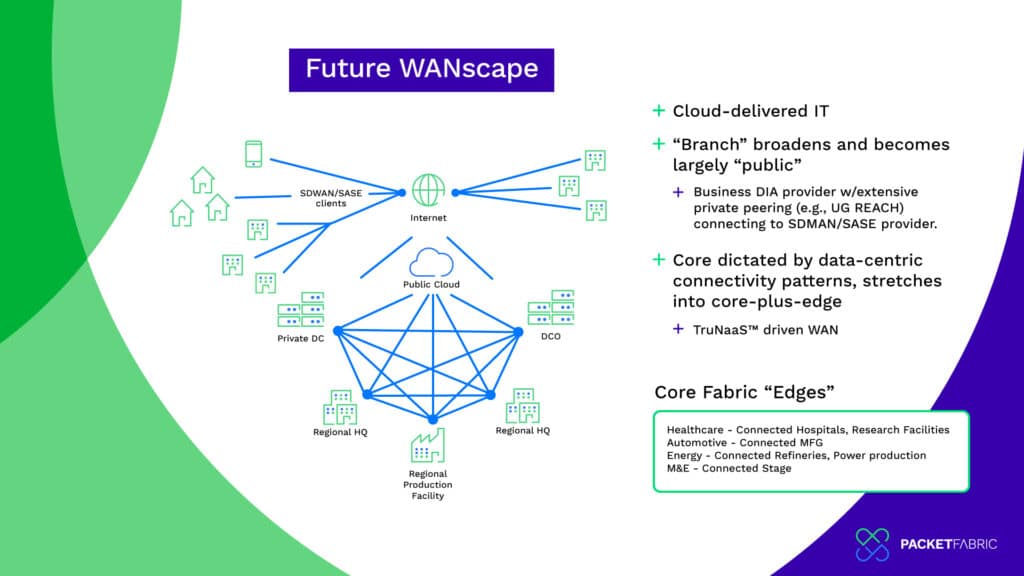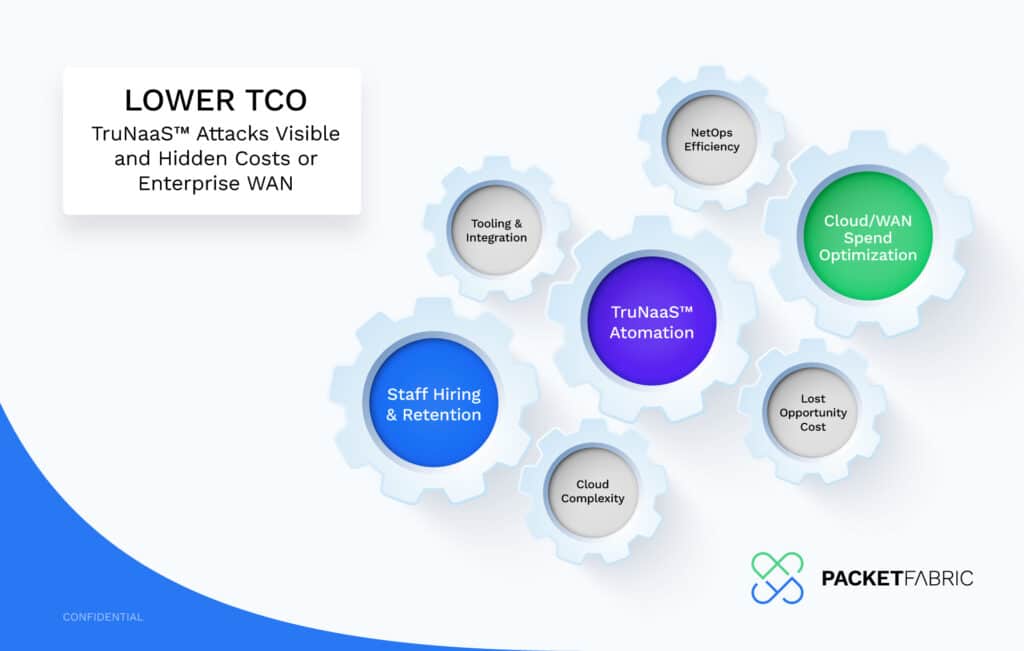On the bright side, at the end of 2022 several large analysis firms were showing a growing interest in Network as a Service (NaaS). However, buried in the upside was a potential brake on popping the champagne cork. While cloud-native companies (most startups) were set to embrace NaaS, traditional enterprises face “skepticism, confusion, and risk aversion“.
Skepticism and the anticipation of “day to day management challenges” always come with the disruption of any new technology. For those aspects of hesitancy, I can say that our PacketFabric TruNaaSTM can be used to create a Wide Area Network (WAN) with the same good characteristics as your existing (traditional) WAN. You’ll still get a private network with the redundancy options and SLAs you had in your past networks but with consumption flexibility you never had before – and that alone will reduce costs. You’ll also get a level of automation and programmability suited for IT focused on digitization of your business.
You don’t HAVE to use our programmability and agility, but it’s always there when you need it and will ultimately make it easy to integrate WAN with your evolving DevOps, SecOps and overall NetOps automation.
Hesitancy in embracing NaaS for WAN may also stem from some uncertainty around the shape of that future enterprise WAN. Still in reactive mode to a pandemic that accelerated cloud consumption and introduced hybrid work challenges, enterprises may simply have not visualized yet what WAN “looks like” after the first wave of digitization washed over the enterprise. They’re not getting a lot of help from their usual advisors either. Some analysts still limit the “private transport” options for the future enterprise WAN to “MPLS.” This could be attributed to the fact that analysis shops often have discipline silos and seeing the shape of the future WAN requires seeing across several silos. That vision takes time to develop.
The Digital 2.0 WAN
But, before you pull the trigger on MPLS renewals for WAN or some over-the-top substitute for your private WAN backbone parading as “NaaS,” you SHOULD try and visualize the future WAN. Here are a few things you can expect in the future structure of enterprise WAN:
We also know that application pipelines perform more efficiently with the tight SLAs around jitter and latency of dedicated private connections than over VPN overlays.
It’s apparent that the “core” and “branch” of the traditional enterprise WAN are being redefined in a new set of contexts. “Branch” is getting broader as every employee becomes a potential branch. “Core” is stretching into core-plus-edge, a data-centric fabric that will need the ability to flex with shifts in data gravity.
In a webinar we held recently around PacketFabric involvement in the Connected Stage evolution in the Media & Entertainment industry, an attendee asked “where IS the edge?” The answer in that context was simply “these new stages”; but more broadly, it would be wherever any industry is going to house and process data as a critical part of their business – because that is likely going to be a collaborative, cloud-connected (public or private) process in the next phases of digital transformation.

PacketFabric TruNaaSTM can address every facet of a future WANscape that is going to require both public and private transport components.
Carrier Grade WAN Delivered as a Cloud Service
TruNaaSTM provides an alternative private transport WAN model with several improvements over the traditional MPLS VPN (L3 or L2). Underpinning our WAN services are our ConvergeTM platform capabilities and something that makes TruNaaSTM a cut above other NaaS offerings for WAN – intelligent network design.
Our experienced network architects and operations experts provide a carrier grade network aligned with enterprise WAN needs that can deliver the tighter SLAs expected/available from private connectivity over a network under our own control.
Our network is built with a diversity of fiber carriers and provides zone based High Availability attachment support for those that need/want it, integrated traffic engineering and support for high bandwidth requirements.
ConvergeTM automation makes consuming network services entirely different. We apply a devops mentality to our NRE/SRE operations to provide a SaaS model and experience to networking that passes our control and visibility through to our customers.
Your “core fabric” (WAN) can be created with either a mesh of Layer 2 interconnections or Layer 3 connections over our private, highly available fiber-optic network. A network that we can now extend to ANY edge with our edge to everywhere capabilities.
Underlying TruNaaSTM intelligent network design and operations automation enable enterprises to confidently break the costly own-to-control model of WAN operation.
Our recently announced merger with Unitas Global will extend our capabilities with public network transport functionality; from automated first/last mile design and acquisition to business internet, extensive peering and IP transit that can complete the total coverage requirements of any future WAN.
Misconceptions about Cost
Since some of the cited confusion and risk aversion expressed about NaaS was around total cost of ownership and “fluctuations in monthly bills,” we should also address a basic misconception around “cloud consumption” as it applies to networking.
A “cloud consumption model” means “use what you need when you need it, and pay for what you use” – a basic statement about the AGILITY of the model, but the consumption metrics for services implementing that model can vary.
The pricing around using public transport (the internet) to connect to public cloud is frustratingly confusing and has a volume variable component controlled by the cloud provider – egress data billed by the GB/month. Consumers’ early experiences with cloud consumption models for other infrastructure (compute and storage) were sometimes unpleasant because of unbounded variable consumption, and that experience reasonably color perceptions of such a model applied to network services.
Happily, direct connections for public cloud connection can be made easily through PacketFabric TruNaaSTM that can limit the potential for “sticker shock” from that variable component. This is one of our first areas of engagement with most customers today.
But more to the point, WAN over TruNaaSTM can operate totally independently of public cloud connectivity and have no variable billing component.
Billing for PacketFabric’s TruNaaSTM WAN services uses (by default) a more traditional WAN metric – bandwidth – but with highly flexible terms and some additional wrinkles that help address the unknowns around the future shape of an enterprise WAN as digitization progresses.
More flexible terms combined with platform enabled on-demand connectivity change the dynamics of enterprise WAN planning.

Total cost of ownership benefits for using TruNaaSTM for WAN go beyond bandwidth spend optimization – your visible costs. NaaS shifts your business operational model to help address the hidden costs of operating a traditional WAN:
Let’s Get Started
Customers that come to PacketFabric for direct cloud connectivity are pleasantly surprised to find that they can build their WAN on our fabric with lower cloud egress costs than public cloud.* While we do provide convenient and easily consumed direct public cloud connections and multi-cloud routing, there’s no need to wait on reimagining the rest of your WAN with NaaS.
Let us help. If you’re one of the tens of thousands of enterprises already using third party data center operator space for your digitization projects, our TruNaaSTM fabric is probably already adjacent to you. Part of the upside of the NaaS model is that the terms and automation make it easy to turn up and turn down – easy to try.
If we’re not immediately adjacent, our Edge to Everywhere capability can make it even easier to extend our fabric to your new edge, whether that’s major office parks, hospitals, manufacturing sites, stages, venues – wherever your edge may be.
*when using more than 30-40% of a 1G connection